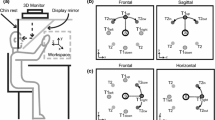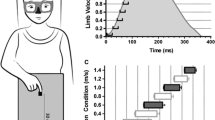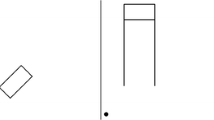Abstract.
Reaching out for objects with an unseen arm involves using both visual and kinesthetic information. Neither visual nor kinesthetic information is perfect. Each is subject to both constant and variable errors. To evaluate how such errors influence performance in natural goal-directed movements, we asked subjects to align a real 5-cm cube, which they held in their hand but could not see, with a three-dimensional visual simulation of such a cube. The simulated cube was presented at one of four target locations at the corners of an imaginary tetraeder. Subjects made successive, self-paced movements between these target locations. They could not see anything except the simulated cube throughout the experiment. Initial analysis of the spatial dispersion of movement endpoints demonstrated that the major source of errors under these conditions was visual. Further analysis of the relationship between variability of the starting positions and endpoints showed that the errors were primarily in judging the endpoint, rather than the direction or amplitude of the required movement vector. The findings support endpoint control of human goal-directed movements.
Similar content being viewed by others
Author information
Authors and Affiliations
Additional information
Electronic Publication
Rights and permissions
About this article
Cite this article
van den Dobbelsteen, J.J., Brenner, E. & Smeets, J.B. Endpoints of arm movements to visual targets. Exp Brain Res 138, 279–287 (2001). https://doi.org/10.1007/s002210100689
Received:
Accepted:
Issue Date:
DOI: https://doi.org/10.1007/s002210100689




